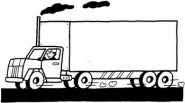|
Prepare for a
Commercial Driver's License Greetings: Thank you for coming! In this project you will learn words used in earning a Commercial Drivers License (CDL). You will learn words and directions used in studying for, taking tests and other pre-requisites for become a Commercial Truck driver. You will learn the process and how to apply for the CDL. Earning your CDL is a three step process. For one, you must learn the rules of the road regarding things like road signs, driving logs, driving down hills, city driving versus open road, parking and rest areas, and so on. Secondly, you will find out that once you pass the written test, you will need to receive training on how to pre-check the truck, how to park (parallel or otherwise), actually drive a truck, with a trainer in the truck with you for a minimum of 30 hours, and finally, take the driver’s test, which entails doing a complete pre-trip inspection, displaying the skills of being able to park, back up and safely drive a pre-designated course. In this project you will collect information relative to CDL’s from fellow classmates who currently possess a CDL, research for information from State Driver’s licensing agencies, and Trucking Companies. You will learn the 5 W’s (why, where, when, who, and what). At the end, you will compile all this information to create a guide to earning a CDL. 1. A. Write out the questions you will need to ask.
2. B. Record all of the feedback that you compile.
(Teacher Note: books will be traded around and viewed by every student and suggestions or questions can be added or asked.) 3. C. Create flashcards, poster and handouts that apply to CDLs.
4. D. Write a paragraph or two to further clarify your findings. E. Play games (with the flash cards or using a chalkboard) or a means of checking competency.
5. D. Check each other’s work for spelling, punctuation and clarity. Note books can be passed around so that the students can check each other’s spelling, clarify a truck part, or otherwise correct any miss-information.
PARAGRAPH WRITING
INTERVIEW
Exemplary: 1. Uses English for interviews. 2. Interviews at least 2 persons. 3. Contacts at least 3 agencies or companies. 4. Includes all 5 W’s. 5. Creates at least 1 set of flashcards and at least two handouts. Satisfactory: Uses English for interviews. 2. Interviews at least 1 person. 3. Contacts at least 2 agencies or companies. 4. Includes all 5 W’s. Creates at least 1 set of flashcards and at least 1 handout. Unsatisfactory: 1. does not use much English. 2. No Interviews. 3. Contacts 1 company. 4. Uses some of the W’s. 5. Creates ˝ set of flashcards – nothing else. Checklist:
Congratulations. You can now go and apply for your CDL! This project is written for an Intermediate to advanced class of learners, but could also include high beginners if they were paired with advanced or intermediates or if project was broken up into smaller pieces. Any student having difficulties or problems will be offered assistance by a tutor. Project is to be Learner-centered as much as possible. (the teacher will prompt and offer suggestions and allow students to self direct and involve each other in all activities) |

